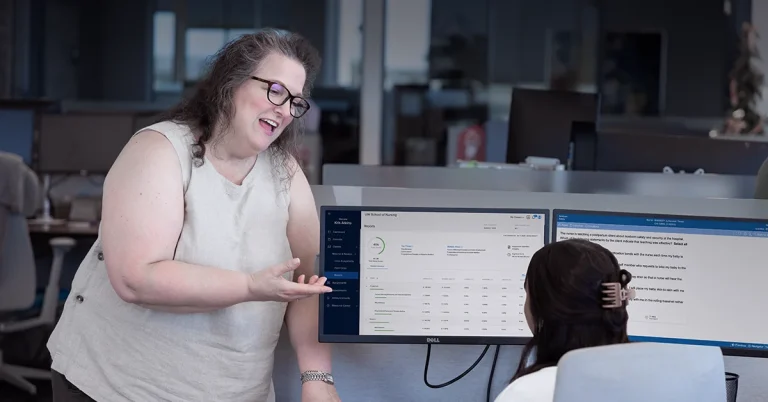By Emily N. Giddings, MSN, RN, CNE, CCRN
With the Next Generation (Next Gen) NCLEX® changes coming up, we wanted to compile a few facts for you to keep in mind as you prepare your program’s transition. These should answer some of the frequently asked questions that the UWorld content team receives about Next Gen item examples, format, and resources. We want to help you prepare for Next Generation NCLEX® success!
What is Next Generation NCLEX®?
Next Generation NCLEX® is a new and improved exam being developed by the National Council of State Boards of Nursing (NCSBN, n.d.-b). The exam will feature new item types and scoring to measure clinical decision-making more reliably than the current exam format. The new items will resemble unfolding clinical case studies and are based on the Clinical Judgment Measurement Model.
Why the change?
Since its inception, the goal of the NCLEX® has been to protect the public by licensing nurses using a “psychometrically sound and legally defensible nursing licensure examination” (NCSBN, n.d.-a, para. 3). The NCSBN determines with a 95% confidence interval that each candidate who passes the NCLEX exam has demonstrated an ability to safely provide nursing care (NCSBN, 2013).
However, nursing practice is becoming increasingly complex as patients advance in age and medical interventions advance in complexity. A recent practice analysis by the NCSBN found that 50% of all entry-level nurses were involved in practice errors and that, of those errors, 65% were related to poor clinical decision-making (Muntean, 2012; NCSBN, n.d.-c). Clearly, a more reliable way to safely measure clinical judgment was needed. In response to this need, the Clinical Judgment Measurement Model was developed (NCSBN, 2019).
What is the Clinical Judgment Measurement Model?
The Clinical Judgment Measurement Model (CJMM) is a model operationalizing a cognitive framework for clinical judgment and decision-making (NCSBN, 2019). The CJMM outlines how clinical decisions are made in response to client needs in a six-step process:
- Recognize cues.
- Analyze cues.
- Prioritize hypotheses.
- Generate solutions.
- Take actions.
- Evaluate outcomes.
The model parallels the nursing process but allows a more granular measurement of the thought processes embedded in clinical judgment and the context surrounding these decisions. These six steps form the six items within Next Gen case studies and can be viewed in “Layer 3” of the CJMM:
Read more about the Clinical Judgment Measurement Model here.
When will the test change?
The NCSBN (2021) has announced that they are on track to fully implement the Next Generation NCLEX® for candidates as early as April 2023. Although 2023 may seem a long way off, it does mean that students beginning a traditional four-semester program in Fall 2021 will be graduating and tested under the Next Generation NCLEX® in Fall 2023.
What exactly will change?
Traditional item types are not flexible enough to measure candidate ability, according to the components of the CJMM. The Next Generation NCLEX® will feature new items embedded in an unfolding, six-part case study (NCSBN, n.d.-c) and stand-alone “trend” items. Brand new item types include:
- Extended drag and drop: Not all response options may be required; there may be more response options than answer spaces.
(Copyright NCSBN, 2021.)
- Cloze (drop-down): There can be more than one drop-down list per item; they may be words or phrases within a sentence or within tables/charts.
(Copyright NCSBN, 2021.)
- Enhanced hot spot (highlighting): The candidate reads part of a client medical record and clicks to select words or phrases; the record can be a note, list, vitals, and so on.
(Copyright NCSBN, 2021.)
- Matrix/grid: The candidate selects one or more options for each row or column.
(Copyright NCSBN, 2021.)
Stand-alone bowtie: These items test one or more of the CJMM components in a single item instead of in a case study.
(Copyright NCSBN, 2021.)
Read more about the new item types here.
Will the whole exam be like this?
No. The exam will still consist mostly of the traditional item types we are accustomed to. Every candidate will receive three 6-part case studies for a total of 18 items (NCSBN, 2021). The remainder of the test will be made of conventional items or up to 10% stand-alone items as seen in the new “bowtie” format and “trend” formats. Candidates will answer between 70 and 135 scored items depending on their performance relative to the passing standard.
Learn more about the new exam length here.
Will the students be allowed more time to answer these questions?
Surprisingly, early analysis of the data has shown that candidates spend only 1-2 minutes per Next Gen item, which is not significantly longer than the average time to answer traditional NCLEX® items. The maximum time allowed for the new exam will be 5 hours, which should allow candidates enough time to answer all items.
Will this complicate scoring and grading?
A little, but this is for the best! Previously, the NCLEX® used dichotomous scoring in which an item was scored as either 100% correct or 100% incorrect. This style of scoring would not reasonably reflect candidate ability if used in the new item types. For example, a matrix/grid item has around 15 possible boxes for a student to either select or leave unselected. Scoring such an item as all-or-none suggests that a candidate who responds correctly to 14 of 15 options has the same ability as a candidate who responds correctly to only 1 of 15. Using partial-credit scoring allows more accurate measurement of a candidate’s ability to compare against the new passing standard.
Learn more about scoring here.
UWorld is working diligently to produce rigorous, high-quality Next Generation questions and explanations. In the meantime, be sure you don’t miss an update on Next Gen developments by subscribing to the NCSBN’s quarterly newsletter here and the UWorld Nursing newsletter. We look forward to partnering with you to help your faculty and students achieve Next Gen NCLEX® success!
References
Muntean, W. J. (2012). Nursing clinical decision-making: A literature review [White paper]. Retrieved July 26, 2021, from https://www.ncsbn.org/Nursing_Clinical_Decision_Making_A_Literature_Review.pdf
National Council of State Boards of Nursing. (n.d.-a). History. NCSBN. Retrieved July 26, 2021, from https://www.ncsbn.org/history.htm
National Council of State Boards of Nursing. (n.d.-b). Next generation NCLEX project. NCSBN. Retrieved July 26, 2021, from https://www.ncsbn.org/next-generation-nclex.htm
National Council of State Boards of Nursing. (n.d.-c). NGN FAQs for educators. NCSBN. Retrieved March 15, 2021, from https://www.ncsbn.org/11447.htm
National Council of State Boards of Nursing. (2013). NCLEX exam: 95% confidence interval rule [Video]. NCSBN. Retrieved July 26, 2021, from https://www.ncsbn.org/5908.htm
National Council of State Boards of Nursing. (2019). Clinical judgment measurement model and action model. Next Generation NCLEX News, Spring 2019, 1–6. https://www.ncsbn.org/NGN_Spring19_ENG_29Aug2019.pdf
National Council of State Boards of Nursing. (2021). Next generation NCLEX update [Online forum post]. NCSBN. https://www.ncsbn.org/15336.htm





